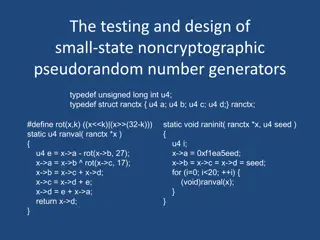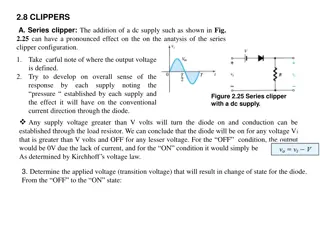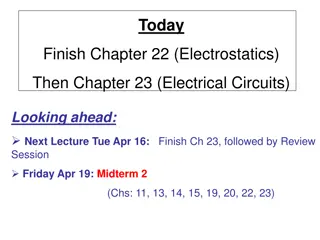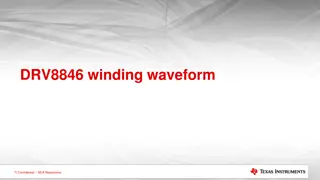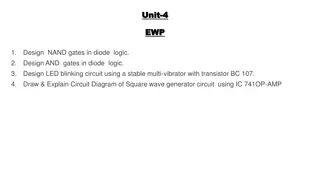Understanding Waveform Generators in Electronic Circuits
Waveform generators, such as square wave oscillators and triangular wave generators, play crucial roles in electronic circuits. Square wave oscillators use capacitors and op-amps to create square wave outputs through charging and discharging processes. On the other hand, triangular wave generators utilize operational amplifiers to produce triangular waveforms by comparing voltages and generating ramps. These devices are fundamental in signal processing and circuit design, providing essential waveforms for various applications.
Download Presentation

Please find below an Image/Link to download the presentation.
The content on the website is provided AS IS for your information and personal use only. It may not be sold, licensed, or shared on other websites without obtaining consent from the author. Download presentation by click this link. If you encounter any issues during the download, it is possible that the publisher has removed the file from their server.
E N D
Presentation Transcript
Waveform Generators Somesh Kumar Malhotra Assistant Professor ECE Department,UIET
Square wave Oscillator/Generator The basic square wave oscillator is based on the charging and discharging of a capacitor. Op-amps inverting input is the capacitor voltage and the noninverting input is a portion of the output fed back through resistors R1and R2(refer figure 1). When the circuit is first turned on, the capacitor is uncharged, and thus the inverting input is at 0V. This makes the output a positive maximum, and the capacitor begins to charge towards voltage at VO through resistor R.
Square wave Oscillator/Generator When the capacitor voltage reaches a value equal to the feedback voltage (Vf) on the non-inverting input, the op-amp switches to the maximum negative state. At this point, the capacitor begins to discharge from +Vf towards Vf. When the capacitor voltage reaches Vf, the op-amp switches back to the maximum positive state. This action repeats and a square wave output voltage is obtained.
Triangular wave Generator This circuit (figure 2) uses two operational amplifiers. Op-amp A1 functions as a comparator and the op-amp A2 as an integrator. Comparator compares the voltage at point P continuously with respect to the voltage at the inverting input; which as at ground potential. When the voltage at P goes slightly below zero, the output of A1 will switch to negative saturation. Suppose the output of A1 is at positive saturation +Vsat. Since this voltage is the input of the integrator, the output of A2 will be a negative going ramp. Thus, one end of the voltage divider R1-R2 is at +Vsat and the other at the negative going ramp.
Triangular wave Generator At time t = t1, when the negative going ramp attains value of Vramp the effective voltage at point P becomes slightly less than 0 V. This switches output of A1 from positive saturation to negative saturation level Vsat. During the time when the output of A1 is at Vsat, the output of A2 increases in positive direction. At the instant t = t2, the voltage at point P becomes just above 0 V, thereby switching the output of A1 from Vsat to +Vsat. The cycle repeats and generates a triangular waveform.
Sawtooth Wave Generator The difference between the triangular and sawtooth waveform is that the rise time of the triangular wave is always equal to its fall time while in sawtooth wave generator, rise time may be much higher than its fall time or vice versa. The triangular wave generator can be converted to a sawtooth wave generator by injecting a variable dc voltage into the noninverting terminal of the integrator. This can be done by using a potentiometer as shown in figure 3. When the wiper of the potentiometer is at the centre, the output will be a triangular wave since the duty cycle is 50%. If the wiper moves towards V, the rise time of the sawtooth becomes longer than the fall time. If the wiper moves towards +V, the fall time becomes more than the rise time.











